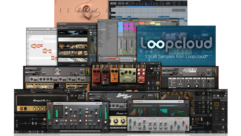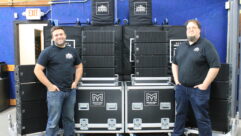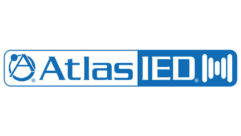
Audio for Multi-use Auditorium, Part 2
Sep 24, 2013 10:32 AM,
With Bennett Liles
Listen to the Podcasts

Editor’s note: For your convenience, this transcription of the podcast includes timestamps. If you are listening to the podcast and reading its accompanying transcription, you can use the timestamps to jump to any part of the audio podcast by simply dragging the slider on the podcast to the time indicated in the transcription.
Schofield Hall on the campus of the University of Wisconsin has to handle everything from lectures to music acts and Audio Architects came up with a sound system that does both with Renkus-Heinz arrays, a Yamaha mixer, and a videowall. Nancy Carlson and Andy Pierson are back with all the details on how it all worked out, coming up next on the SVC Podcast.
SVC: Alright, Nancy Carlson and Andy Pierson thanks for being back with us for part two on the SVC Podcast from Audio Architects and we’re getting into the Schofield Hall AV project with the big renovation and upgrade there. I think part of the sound system on this also involved four Renkus-Heinz DR18-2R dual 18in. powered subwoofers.
Andy Pierson: Thank you for having us. Yes, we were supplementing the Renkus-Heinz IC Live triples on either side with two dual 18in. powered subwoofers. So we have a total of four dual 18 boxes where we hide those behind some acoustical treatment in the room, on either side of the room. Those certainly gave us more than enough bottom end to accompany any setup or musical group that would enter into the space.
Nancy Carlson: It also gave the general contractor that was part of the project a bit of pause trying to figure out how he would support the platform that the subwoofers sit on because the subwoofers themselves are quite heavy and then when you put that much sound through the subwoofers, it has the potential to move a little bit, or vibrate and everything like that. So it was a fun discussion that day when we were calculating out exactly what we would have to do for supporting those in those little spaces next to the stage.
Pierson:: Correct. So there was a lot of additional infrastructure that was added to support the subwoofers in their hidden space. [Timestamp: 2:11]
We’ll it was a huge advantage for you to be able to get in there as part of a much bigger renovation project.
Carlson: Exactly. There was a general contractor, an electrician, and it was a very large upgrade to Schofield for audio and video and everything, so it definitely needed a lot of players in there and we were happy to be part of it. [Timestamp: 2:30]
We talked a little in part one about the front of house mixer. What do they use in there and where do they put it?
Pierson:: Oh, that was a Yamaha M7 and that mixer actually can be plugged in in two different locations. It had a dedicated sound booth on the second floor up in the balcony. Additionally, it has another mixer position, which is in the back under-balcony area of the auditorium. It added additional flexibility, because sometimes when you were up in the sound booth, you weren’t able to hear quite as well since it had some enclosure; it was an enclosed space. So having the flexibility to be able to reroute it and run it in the back of the room added a lot of flexibility and also helped to meet some riders if you had a musical group in that required it to be actually in the room. [Timestamp: 3:19]
Wow, that would be strange trying to mix live sound in a completely isolated and separate acoustic environment.
Pierson:: Absolutely.
And I think you mentioned before that it’s Ethersound connected? It’s a digital connection to the system.
Pierson:: Correct. In fact we’re using two different digital connections. We’re using an Ethersound snake as far as to grab all the inputs from the stage location, and additionally we’re outputting CobraNet, so we actually have two digital connections. [Timestamp: 3:43]
Well at those cable runs, that beats an old copper pair analog snake.
Pierson:: We have an analog backbone in the room as well, so just in case any other mixers are required to fit a rider, we can also drop an analog board into place. [Timestamp: 3:57]
OK, so you got the Iconyx system and you have the Yamaha mixer. Is there any other audio gear like power, intercom, or playback stuff that was installed as part of this?
Carlson: There is a client processor. The [Biamp] AudiaFlex is what we used for the main processor for that. We have a few other ancillaries in there for up-board speakers. We do have speakers in the hallway, just outside of Schofield, so if they’re doing a big production it can sort of have a foyer space. There’s also a paging intercom system that goes all throughout Schofield. It’s in the ticket booth, it’s in the green room, and a few other places in the building where that goes so they can all communicate back and forth. We have a full monitor system with the EAW Microwedge under there. [Timestamp: 4:45]
And you’ve got control over the individual speaker arrays or was that just part of the initial setup? Have you got presets on those that you can punch up for different types of events?
Pierson:: The way we handled the presets was really to just to divide the system up for a speech versus a music system. And so we were able to handle that by basically taking all of the automated speech microphones, as it were, for forums and routing them just directly into the Biamp system. And then the Yamaha mixer is more of their musical system, in which case it’s just treated differently as far as those mic lines. The EQ and everything is then subject to the M7, first being preset to kind of a speech application. Now the other kind of division for that is then how it’s routed internally from the Biamp system. So for example, all the speech microphones are not routed to the subwoofers, whereas the Yamaha mixer then gives the ability to route any of the inputs to the subwoofer system individually. [Timestamp: 5:45]
1
Audio for Multi-use Auditorium, Part 2
Sep 24, 2013 10:32 AM,
With Bennett Liles
Oh well that’s a great way to go where you have it like two separate systems, sort of a speech animal and a separate music system.
Pierson:: Correct. And there’s also a number of wireless microphones that are part of the system as well, so there was a total of eight wireless Sennheiser systems that were included with the system in which case, due to the flexibility of the system, we can either route them just directly as a speech system or we can route them back to the mixer to have control over them in that location. [Timestamp: 6:13]
This is a really ambitious project. That’s a lot of gear to get put in place and connected and tested. What kind of a timeframe did you have on getting this whole thing done?
Carlson: The project itself, construction-wise, started in June and we started getting in there, really to get the wire pulled and get the backbone in probably about September. And we were finishing up the last tuning and programming and whatnot in January. So the whole thing was about six, seven months. [Timestamp: 6:40]
That’s not bad. You had time to make sure that everything is put in right. Was there anything unexpected that came up with all of this that you had to deal with?
Carlson: The columns for the speakers; there was some discussions about that as far as looking at it from the architectural side, was that it looks like it was part of the room, but also that it would still work to house the speakers. So we had to have a whole discussion about putting the speaker 6in. behind the column and still expect it to project into the room and being able to talk the different languages with the architect and the general and the school and everything like that, so. [Timestamp: 7:16]
Ah, the old acoustics versus aesthetics debate.
Carlson:Yes, yes. That’s the name of the debate.
Yeah, well it never ends, especially if you have an old historic building or something. So when you rang all of this out and tested it did everything pretty well work out as planned?
Pierson: Oh, absolutely. In fact one of the most pleasing parts was the first time it got fired up after Ralph finished tuning it up for us. The output was just purely amazing, and it achieved some of our main goals, which was to get underneath the balcony in the back of the room with all the intelligibility that we needed to showcase all of the forums. [Timestamp: 7:52]
Did you run into any power or grounding situations that caused a problem?
Pierson: There was a full power redo for the space, so there was an electrician that came in and did extensive work on the power system. In fact, it actually required a new main feed from one of their other buildings … in order to provide enough power for the room. So all of the system is protected using some SurgeX and additionally it’s sequenced using some of the Crestron Green Light systems. [Timestamp: 8:27]
Oh well that’s great because after all the work you do on the sound system to power it up and then find that there are issues with that is a real crusher.
Pierson: Correct.
Carlson: They tried to cover all of their bases with this project. They said, “We want to do it once, we want to do it right, and we want it to last for a long time afterwards.”
And what was the video side of this project? What did they need in there for the video side?
Pierson: This was one of the more unique ones, for us at least, the first time we’ve installed a videowall. This system actually consisted of a four-by-four videowall consisting of 55in. flatpanel TVs. One of the most unique parts about having a videowall is how it serves as a backdrop for a lot of the different events; a very unique use of it. One of the advantages is instead of using a projector, in which case the presenters would always be in front of it creating a shadow on the screen, by using a videowall there aren’t any shadows. And we’re still able to get the image large enough and crisp enough by using both the Crestron processors in order to create the videowall, but the image itself, I think one of the most notable performance values of it, is just how it is supplemental to the lighting and as a most unique backdrop. So if you have a band, for example, playing, then you can have a very dynamic background. It also works very well for some of their forums. So for example, when they have a hypnotist come in and do an event or a magician come in. So it’s really quite a unique thing to have a videowall versus a projection system in that space. Additionally it gave it another wow factor or an additional wow factor. [Timestamp: 10:09]
Yeah, I would think so. For the music acts you might want to have some continuous motion video going on in the videowall and for the lectures and discussion formats maybe something that looks more like a static backdrop.
Carlson: They’ve done some really fun things with lighting and color using both the actual stage lights and the videowall together so that it almost works seamlessly together. It’s really fun how creative they’ve been able to be with that.
Alright, well it sounds like you turned it into a real fun place.
Pierson: Absolutely. The video system as well as the automated audio system and the screens and basic lighting is all controlled, then, by Crestron.
And from some central location?
Pierson: Well, actually, there’s a location up in the booth. There’s some basic lighting control around the auditorium and additionally there’s a 6in. wireless touchpanel that works with their podium. [Timestamp: 11:01]
Okay, so they can do it from anywhere.
Pierson: Correct. It also was nice to have the flexibility of the wireless touch panel so that if you’re moving the front-of-house position from either the booth down to the floor location, that you could still control the lights and the curtains and the videowall. [Timestamp: 11:17]
Well, that sounds like a really interesting job and a long enough time period where you didn’t have to rush through it. So you got this one done. What’s coming up for Audio Architects? Have you got something interesting in the pipeline?
Carlson: Well we’re in the middle of a project at one of the other university campuses right now, to design an arena system for them. We have a number of school projects, K through 12, right now. This is a big time for them, so a number of projects happening there. Some fun church projects happening in the fall. Once the schools are taken care of, we have some fun church ones coming up.
Coming up with essentially two different sound systems and the videowall. Thanks for telling us about it. Andy Pierson and Nancy Carlson from Audio Architects in Chippewa Falls, Wis., and the Schofield Hall renovation with sound and video. Great to have you with us.
Thank you for having us.
2










